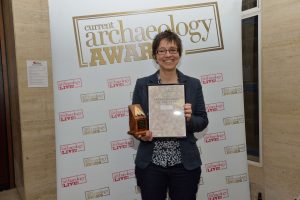Dr Hella Eckardt, Associate Professor of Archaeology at the University of Reading, has just been named Archaeologist of the Year by Current Archaeology magazine. Part of her research is focused on uncovering evidence of how diverse the Roman Empire was, which in turn informs modern-day discussions about immigration. Here, Dr Eckardt discusses the scientific techniques used in her research and how the findings can be best communicated in schools.

There has been recent discussion about the importance of bringing the past to life for school children. One way to do this is to examine how archaeology might provide a different perspective on some major current debates, for example around migration.
A few years ago, I worked with my colleagues Gundula Müldner and Mary Lewis on around 150 burials from Roman Britain, trying to learn more about their geographical origin and cultural identities.
As an artefact specialist, I am quite used to identifying apparently exotic or unusual objects, but it was really fascinating to test whether the people buried with them were immigrants or not.
We used new scientific techniques such as isotope analysis, which examines the chemical signatures preserved in teeth and essentially reflect the water and food that a person consumed in childhood. The technique is better at excluding local origin than pinpointing specific origins, so we can normally only say broadly that an individual came from somewhere cooler or warmer.
We identified a number of late Roman individuals in Scorton, York and Winchester who appear to originate from cooler areas, such as Germany or Poland. This makes sense because we know that mercenaries came from those areas served in the Roman army.
Another technique measures various aspects of ancient skulls, to establish African or Caucasian ancestry. For example, a 4th century skeleton from York was identified as the remains of a woman aged 18-23 years, buried with rich grave goods that included both locally available (jet) and exotic (ivory) bracelets as well as an array of other impressive grave goods.
Her facial characteristics suggest that she had a mixture of traits common in European (‘white’) and African (‘black’) populations but the results of the isotope analysis are ambiguous – she does not appear to have grown up in North Africa, so may be a second generation migrant.
Finally, there is genetic data, as in the case of the so-called ‘headless Romans’ from York. This is an unusual cemetery of mainly male individuals, many of whom were beheaded and some of whom bear injuries from large carnivores or combat. DNA analysis demonstrated that while most appear to be of broadly ‘British’ descent, one individual may be from the Middle East; he also has an unusual isotope signature.
The relationship between exotic burial rite or artefacts and isotopic evidence for geographical origin is not straightforward – there are cases of incomers that have ‘blended in’ and locals who have adopted new ways of doing things.
Another factor to think about is the old archaeological cliché that people don’t bury themselves – we are seeing what their family or friends chose to do. The Roman Empire as a whole, and even a marginal province such as Britain, was characterised by relatively high levels of mobility. Most of this migration was by high status individuals but others, for example slaves were moved against their will.
Contributing to current debate
A few years on, and given the huge and often emotive debates around migration, I have begun to think much more about how we can communicate these findings to the wider public, and hopefully make a constructive contribution to current debates. The idea is not to expect straightforward validation for current political points from archaeological evidence, but what archaeology can do is to provide an increasingly rich and complicated picture of life, which we can compare and contrast with other societies and different time periods.
It is especially important that school children, who cover ‘the Romans’ at Keystage 2, learn that the Roman Empire was not homogenous, but characterised by the interplay of locals and newcomers in wonderfully complex ways.
We tried to convey this message through our Romans Revealed website and teaching resource. We are also currently working with museums, including the Museum of London and Corinium Museum, to develop educational sessions that help children explore diversity in the Roman world.
